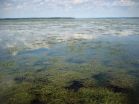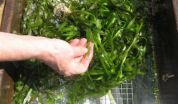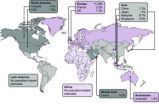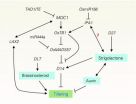(Press-News.org) CAMBRIDGE, MD (September 2, 2014)—The Susquehanna Flats, a large bed of underwater grasses near the mouth of the Susquehanna River, virtually disappeared from the upper Chesapeake Bay after Tropical Storm Agnes more than 40 years ago. However, the grasses mysteriously began to come back in the early 2000s. Today, the bed is one of the biggest and healthiest in the Bay, spanning some 20 square miles. A new study by scientists at the University of Maryland Center for Environmental Science explores what's behind this major comeback.
"This is a story about resilience," said Donald Boesch, president of the University of Maryland Center for Environmental Science. "It's a powerful example of how organisms in ecosystems once given a chance can make themselves resistant to stresses and changes."
Underwater grasses are important to the Bay because they provide habitat for juvenile fish and enhance water clarity by trapping and removing sediment from the water. Historically extolled by trophy fisherman and waterfowl enthusiasts as prime wildlife habitat, researchers believe that the underwater grass beds at the shallow Susquehanna Flats began to decline in the 1960s when polluted runoff from a rapidly developing watershed overwhelmed the Bay's waters with nutrients, causing algae blooms that blocked out much-needed sunlight for underwater plants.
"Underwater grasses are sensitive to water quality so they are a direct indicator of the Bay's health," said lead-author Cassie Gurbisz of the Center's Horn Point Laboratory. "The fact that they came back means something good is happening. It's important, however, for us to understand how they came back so we can use that information to support restoration in other areas."
With SAV already stressed by nutrient pollution, it was Tropical Storm Agnes in 1972—a three-day weather event in June that dumped up to 19 inches of rain on the region and an estimated 30 million tons of sediment into the Chesapeake Bay—that was the final blow that destroyed the bed. A torrent of polluted floodwaters and sediment overwhelmed the beds, and the submerged plants virtually disappeared for nearly three decades. That is until the early 2000s when the underwater grasses, also called submerged aquatic vegetation (SAV), rapidly recolonized nearly the entire region.
"This was a large and abrupt resurgence. The Susquehanna Flats SAV bed is gigantic--the largest in the Chesapeake, with multiple species of grasses," said Professor Michael Kemp. "When you're out on the Flats in summer at low tide, you see these plants at the water surface all around you, and it's a truly awe inspiring scene."
It was clear that the extreme flood event following Tropical Storm Agnes triggered the historic demise of the grasses at Susquehanna Flats, however the extended absence of SAV for over 30 years—and the rapid comeback in the last decade—was puzzling to scientists. Researchers analyzed recent and historical data to try to develop a model that explains this resurgence. Monitoring programs throughout the years provided a wealth of information on underwater grasses (since 1958), water quality (since 1984) and even climate-related variables, such as temperature and rivers discharge dating back to the late 1800s.
Researchers found that modest reductions in nutrient pollution to the Bay beginning in the late 1980s had led to long-term improvements to water clarity and the amount of light available for plants to grow underwater. A dry period from 1997-2002 combined with the absence of major storm events provided ideal conditions for new plant growth, and a critical threshold for the amount of light reaching the plants was crossed. As a result, the bed began to expand and colonize deeper water.
"Exceptional growing conditions during the drought period allowed the system to overcome turbid water and served to kick start a rapid resurgence," said Cassie Gurbisz. "Light availability is the most important factor in the growth of submersed plants."
Then the plants took over with a process called positive feedback. That is, once given a chance, grass beds can improve their own growing conditions by helping sediment drop to the bottom and stay there (increasing the amount of sunlight that can reach their leaves), and using excess nutrients in the water to grow. The researchers found lower nitrogen concentrations and less turbidity in the grass beds than the surrounding waters.
These feedbacks also affect a plant bed's resilience, or its ability to resist disturbances such as storms and rebound after they pass. The researchers note that in the decade before Tropical Storm Agnes, the bed was deteriorating. As a result, feedbacks were not very strong and the bed was unable to stand up to Agnes. The present bed is, evidently, more resilient. When major floodwaters flowed from the Susquehanna River in Fall 2011, a portion of the bed was lost. However, the remaining bed has continued to thrive and expand.
"These processes and patterns are not unique to Susquehanna Flats. Similar trends have been suggested for the Mid-Atlantic Coastal Bays and Northern Europe alike," said Kemp. "Our broader motivation lies in the idea that the methods and models used here can be applied elsewhere to explore similar plant bed dynamics around the world."
The paper, "Unexpected resurgence of a large submersed plant bed in Chesapeake Bay: Analysis of time series data," by Cassie Gurbisz and Michael Kemp of the University of Maryland Center for Environmental Science's Horn Point Laboratory, was published in the March 2014 issue of Limnology and Oceanography.
INFORMATION:
Univertsity of Maryland Center for Environmental Science
The University of Maryland Center for Environmental Science unleashes the power of science to transform the way society understands and manages the environment. By conducting cutting-edge research into today's most pressing environmental problems, we are developing new ideas to help guide our state, nation, and world toward a more environmentally sustainable future through five research centers—the Appalachian Laboratory in Frostburg, the Chesapeake Biological Laboratory in Solomons, the Horn Point Laboratory in Cambridge, the Institute of Marine and Environmental Technology in Baltimore, and the Maryland Sea Grant College in College Park. http://www.umces.edu
Underwater grass comeback bodes well for Chesapeake Bay
2014-09-02
ELSE PRESS RELEASES FROM THIS DATE:
Men who exercise less likely to wake up to urinate
2014-09-02
MAYWOOD, Ill – Men who are physically active are at lower risk of nocturia (waking up at night to urinate), according to a study led by a Loyola University Chicago Stritch School of Medicine researcher.
The study by Kate Wolin, ScD, and colleagues is published online ahead of print in Medicine & Science in Sports & Exercise, the official journal of the American College of Sports Medicine.
Nocturia is the most common and bothersome lower urinary tract symptom in men. It can be due to an enlarged prostate known as benign prostatic hyperplasia (BPH) -- as the prostate ...
Observing the onset of a magnetic substorm
2014-09-02
Magnetic substorms, the disruptions in geomagnetic activity that cause brightening of aurora, may sometimes be driven by a different process than generally thought, a new study in the Journal of Geophysical Research: Space Physics shows.
Hwang et al. report observations using the Cluster spacecraft and ground-based magnetometers associated with the onset of a substorm. They saw two consecutive sudden jumps in the current sheet normal component of the magnetic field in the plasma sheet (the surface of dense plasma that lies approximately in Earth's equatorial plane), separated ...
Researchers uncover hidden infection route of major bacterial pathogen
2014-09-02
Researchers at the University of Liverpool's Institute of Infection and Global Health have discovered the pattern of infection of the bacterium responsible for causing severe lung infections in people with cystic fibrosis.
Pseudomonas aeruginosa is usually harmless to humans, but in people with cystic fibrosis (CF) or who have weakened immune systems – such as those who have had an operation or treatment for cancer – it can cause infections that are resistant to antibiotics. In CF patients in particular, infections can be impossible to eradicate from the lungs.
The ...
Aging gracefully: Diving seabirds shed light on declines with age
2014-09-02
Scientists who studied long-lived diving birds, which represent valuable models to examine aging in the wild, found that blood oxygen stores, resting metabolism and thyroid hormone levels all declined with age, although diving performance did not. Apparently, physiological changes do occur with age in long-lived species, but they may have no detectable effect on behavioral performance.
The Functional Ecology findings suggest that reductions in metabolism with age can be viewed as strategic restraint on the part of individuals who are likely to encounter energy-related ...
Could poor stomach absorption of drugs reduce autism medications' effectiveness?
2014-09-02
Recent research has revealed that many children and adults with autism experience gastrointestinal symptoms and that such symptoms can impact the absorption and availability of medications.
Because approximately 35% of people with autism take at least one psychotropic medication to help control their symptoms, the authors of a Journal of Clinical Pharmacology commentary are calling for a formal evaluation of the potential relationship between gastrointestinal symptoms and the effectiveness of autism medications. Alternative modes of drug administration may be needed to ...
Modern population boom traced to pre-industrial roots
2014-09-02
The foundation of the human population explosion, commonly attributed to a sudden surge in industrialization and public health during the 18th and 19th centuries, was actually laid as far back as 2,000 years ago, suggests an extended model of detailed demographic and archeological data.
The Public Library of Science One (PLOS ONE) recently published the analytical framework developed by Aaron Stutz, an associate professor of anthropology at Emory University's Oxford College.
"The industrial revolution and public health improvements were proximate reasons that more people ...
New name for symptoms associated with menopause
2014-09-02
Experts who reviewed the terminology associated with genitourinary tract symptoms related to menopause—currently referred to as vulvovaginal atrophy—have agreed that the term genitourinary syndrome of menopause (GSM) is a medically more accurate, all-encompassing, and a more publicly acceptable term. Their thoughts are published in a recent Journal of Sexual Medicine article.
Going forward, GSM will encompass a collection of symptoms and signs associated with a decrease in estrogen and other sex steroids and may include genital symptoms of dryness, burning, and irritation; ...
Extinctions during human era worse than thought
2014-09-02
PROVIDENCE, R.I. [Brown University] — It's hard to comprehend how bad the current rate of species extinction around the world has become without knowing what it was before people came along. The newest estimate is that the pre-human rate was 10 times lower than scientists had thought, which means that the current level is 10 times worse.
Extinctions are about 1,000 times more frequent now than in the 60 million years before people came along. The explanation from lead author Jurriaan de Vos, a Brown University postdoctoral researcher, senior author Stuart Pimm, a Duke ...
Time to take notice and tackle heart failure
2014-09-02
Experts have sounded a call to action for policy makers at local, national, and international levels to promote heart failure prevention, improve heart failure awareness among healthcare professionals, ensure equity of care for all patients with heart failure, support and empower patients and their caregivers, and promote heart failure research.
Despite the increasing numbers of people living with and dying from heart failure, awareness of the disease is low among the public, politicians, and even some healthcare professionals. Although there is no cure for heart failure, ...
Chinese scientists' team efforts in dissecting rice complex agronomic traits in recent years
2014-09-02
Rice is a main food source for more than half of the global population and is a model plant for genome-based research.
Since the turn of the century, Chinese scientists have embarked on a "Long March" toward more intricate understanding of the complex agronomic traits of rice, spurred in part by the completion of the draft genome sequence of the indica variety 93-11 and a fine sequence analysis of chromosome 4 of the japonica variety Nipponbare.
These researchers "have made crucial contributions to international efforts in sequencing the rice genome," report Jianru Zuo ...




